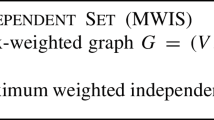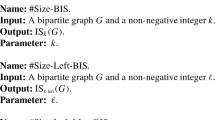Abstract
The problem of counting the number of independent sets of a graph G (denoted as NI(G)) is a classic #P-complete problem for graphs of degree 3 or higher. Exploiting the strong relation between NI(G) and Fibonacci numbers, we show that if the depth-first graph of G does not contain a pair of basic cycles with common edges, then NI(G) can be computed in linear time (in the size of the graph). This determines new classes of instances of graphs without restrictions on their degrees and where the number of independent sets is computed in polynomial time.
We design an exact deterministic algorithm for computing NI(G) based on the topological structure of the graph G, applying the well-known splitting rule from Davis and Putnam (D&P) procedure. D&P is a familiar method for solving the Satisfiability Boolean Problem. Our algorithm for computing NI(G) establishes a leading Worst-Case Upper Bound of O( poly(n,m)* 1.220744n), n and m being the number of nodes and edges of the graph G, respectively. The exact technique reported here can be used to compute the redundancy of a line in a communication network.
Preview
Unable to display preview. Download preview PDF.
Similar content being viewed by others
References
Angelsmark, O., Jonsson, P.: Improved Algorithms for Counting Solutions in Constraint Satisfaction Problems. In: Int. Conf. on Constraint Programming, pp. 81–95 (2003)
Arocha, J.L.: Propiedades del polinomio independiente de un grafo. Revista Ciencias Matemáticas V, 103–110 (1984)
Dahllöf, V., Jonsson, P., Wahlström, M.: Counting models for 2SAT and 3SAT formulae. Theoretical Computer Sciences 332(1-3), 265–291 (2005)
De Ita, G., Tovar, M.: Applying Counting Models of Boolean Formulas to Propositional Inference. In: Advances in Computer Science and Engineering, vol. 19 (2006)
Dyer, M., Greenhill, C.: Some #P-completeness Proofs for Colourings and Independent Sets, Research Report Series, University of Leeds (1997)
Dyer, M., Frieze, A., Jerrum, M.: On Counting Independent Sets in Sparse Graphs. SIAM J. Comput. 31(5), 1527–1541 (2002)
Dyer, M., Greenhill, C.: Corrigendum: The complexity of counting graph homomorphism. RSA: Random Structures and Algorithms 25, 346–352 (2004)
Greenhill, C.: The complexity of counting colourings and independent sets in sparse graphs and hypergraphs. Computational Complexity 9(1), 52–72 (2000)
Hoede, C., Li, X.: Clique polynomials and independent set polynomials of graphs. Discrete Mathematics 125, 219–228 (1994)
Levit, V.E., Mandrescu, E.: The independence polynomial of a graph - a survey, Holon Academic Inst. of Technology (to appear)
Luby, M., Vigoda, E.: Approximately counting up to four. In: Twenty-Ninth Annual Symp. on Theory of Computing, pp. 682–687. ACM, New York (1997)
Roth, D.: On the hardness of approximate reasoning. Artificial Intelligence 82, 273–302 (1996)
Russ, B.: Randomized Algorithms: Approximation, Generation, and Counting, Distinguished dissertations. Springer, Heidelberg (2001)
Vadhan Salil, P.: The Complexity of Counting in Sparse, Regular, and Planar Graphs. SIAM Journal on Computing 31(2), 398–427 (2001)
Author information
Authors and Affiliations
Editor information
Rights and permissions
Copyright information
© 2007 Springer-Verlag Berlin Heidelberg
About this paper
Cite this paper
De Ita, G., López-López, A. (2007). A Worst-Case Time Upper Bound for Counting the Number of Independent Sets. In: Janssen, J., Prałat, P. (eds) Combinatorial and Algorithmic Aspects of Networking. CAAN 2007. Lecture Notes in Computer Science, vol 4852. Springer, Berlin, Heidelberg. https://doi.org/10.1007/978-3-540-77294-1_9
Download citation
DOI: https://doi.org/10.1007/978-3-540-77294-1_9
Publisher Name: Springer, Berlin, Heidelberg
Print ISBN: 978-3-540-77293-4
Online ISBN: 978-3-540-77294-1
eBook Packages: Computer ScienceComputer Science (R0)




